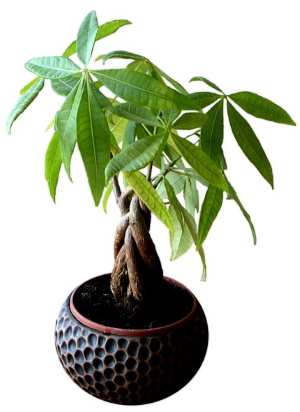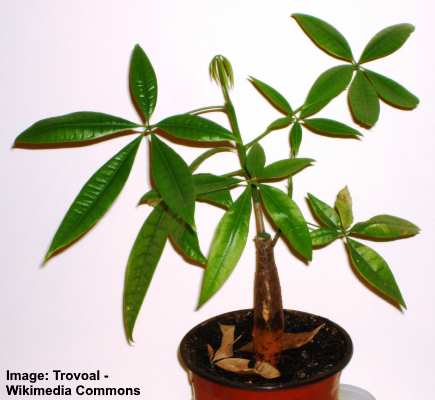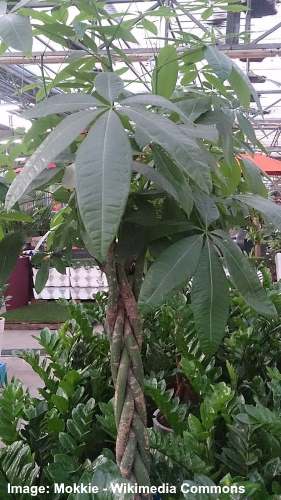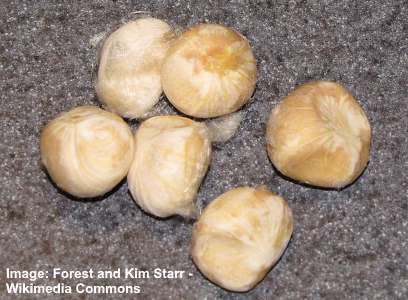Money Tree Plant (Pachira Aquatica): Care, Types, Pictures and More

Money tree is the common name for a species of tree called Pachira aquatica. The money tree is a popular ornamental houseplant and it is said to bring good luck, prosperity, and good fortune according to the Chinese Feng Shui. This type of money plant is usually seen with braided or twisted trunk and it has lush green foliage growing at the top. Money trees are popular indoor bonsai plants due to their reputation of inviting wealth and being easy to care for and look after.
How to care for Pachira Aquatica: For the money tree plant to thrive, grow in bright indirect light and plant in well-draining potting soil. Only water when the topsoil is completely dry and keep high humidity levels. The ideal temperature range is between 53°F and 77°F (12°C – 25°C). Fertilize twice a year in spring and fall.
Pachira aquatica (money tree) is a tropical tree species in the family of plants named Malvaceae. This means that money trees are related to hibiscus, cotton, and cacao plants. Other names for this type of money tree include Malabar chestnut, Provision tree, Guiana chestnut, and French Peanut.
In the wild, Malabar chestnuts (Pachira aquatica) can grow up to 60 ft. (18 m) tall. As an indoor ornamental plant, it is grown as a bonsai tree where its height and growth can be regulated with care and pruning. When growing outdoors, money trees have distinctly showy flowers. As an indoor houseplant, money trees rarely, if ever, flower. Usually, an indoor money tree grows to between 1 and 6 ft. (0.3 – 1.8 m) tall.
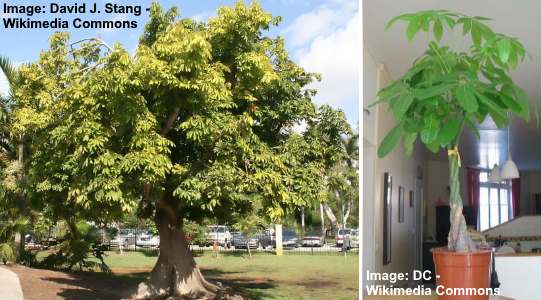
Left picture: Pachira aquatica in the wild. Right picture: Pachira aquatica as an indoor bonsai tree
Bonsai money trees are popular as a dwarf house plant and can look elegant on a desk, window sill, or shelf.
One of the identifying features of money trees is the large green leaves shaped like a lance tip (lanceolate). Each stem grows 5 or 6 palmate-shaped leaves and, if you are especially “lucky,” you may find one with 7 leaves. Braiding between 5 and 8 stems together gives the top of the money tree a bushy look.
Types of Money Plants With Their Picture and Common Name
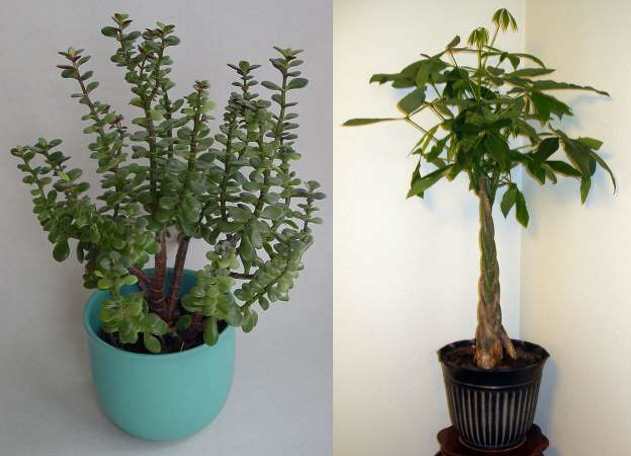
Left: Crassula ovata (jade plant or money plant) has tree like appearance. Right: Pachira Aquatica (money tree plant) with twisted / braided trunk. Both plants are said to bring good fortune according to the Feng Shui
The money tree (Pachira aquatica) is just one of the two auspicious plants that Feng Shui says bring good luck. According to Chinese Feng Shui practitioners, twisting the money tree stems to braid them helps to create positive energy and promote financial success. It is said that the best place to put money plants is at a door to invite prosperity or in areas where financial work is carried out.
The other Feng Shui money plant that is believed to boost financial prosperity is the species of jade plant Crassula ovata. This “lucky plant” is also called the money tree and is a type of succulent. The jade plant has coin-shaped leaves (hence its connection to wealth), thick woody stems, and shrub-like appearance.
Money Tree Bonsai
Pachira aquatica or money tree is usually grown indoors as a braided bonsai tree. The twisted or braided trunk of the money tree plant adds to its ornamental look. These dwarf indoor money trees are often given as gifts to encourage fortune, wealth, and property. Because of their small size, these bonsai trees can be placed anywhere where they get moderate sunlight.
Read up on how to braid money trees and keep them as small bonsai trees in the shape you want.
How to Care for a Money Tree (Pachira Aquatica)
You don’t need to leave it to luck to make your money tree grow well and prosper. With the right care and attention, your money tree can grow for years.
Although a large money tree doesn’t mean greater wealth, their rich green foliage adds beauty and grace to any room.
Let’s look in more detail at how to take care of a money tree.
How to water a money tree (Pachira Aquatica)
One of the most important ways to care for your money tree is to ensure regular watering. The best kind of soil is well-draining soil that allows excess moisture to drain out the bottom.
The way to know when it’s time to water your money tree is when about 1” (2.5 cm) of the topsoil is completely dry. When it is time to water your money tree, pour rainwater or filtered water into the soil until it drains out the bottom of the pot. Leave until it dries out before watering again.
Because your money tree needs plenty of humidity, misting it occasionally can help to encourage healthy growth. You could also give your money tree a shower every so often. This can help to provide enough moisture, remove dust from the leaves, and thoroughly water the soil.
During winter, only water your money tree occasionally when the soil looks and feels very dry.
One of the signs that you are watering your money tree plant too much is if the leaves start falling off. If this happens, hold off watering until the top part of the soil is completely dry.
Light requirements of Pachira Aquatica
Apart from being said to invite wealth and prosperity, a reason why money trees are popular is that they grow well indoors.
The best location to place your money tree in your home is in a bright area where there is partial shade or indirect sunlight. It is also a good idea to turn the plant every so often to encourage even growth.
Money trees also grow well under artificial light and are also forgiving if they have to endure periods of low light.
If you want to keep your money tree in direct sunlight, introduce it gradually. This will help to acclimatize the tree and prevent leaf burn.
Temperature and humidity
As an easy-to-care-for houseplant, money trees thrive in room temperature and high humidity. The ideal temperatures for your “good luck” tree to grow are between 53°F and 77°F (12°C – 25°C).
If you live in USDA zones 10 and 11, you will be able to grow your money tree outdoors. Some Feng Shui practitioners place these lucky trees at the front door to invite fortune into the home.
Even though a money tree can withstand temperatures as low as 41°F (5°C), this is not recommended. If the plant starts dropping its leaves, it could be a sign of cool temperatures and it should always be kept above 77°F (12°C). Growth should return in the spring when the weather gets warmer.
Feeding
To care for your Chinese money tree houseplant, you only need to use bonsai fertilizer occasionally. Bonsai money tree only needs to be fertilized twice per year – in spring and in fall to help it grow well.
Repotting
You may have to repot your money tree every 2 or 3 years when it starts actively growing in spring. The best kind of pots for money trees should have drainage holes in the bottom and be about 2” (5 cm) larger than its current one.
The best kind of soil to choose for your “Good Luck” tree should be quick-draining soil. Usually, sandy peat-moss soil is the best choice. This most important care tip for growing money trees in pots is to ensure the roots are never soggy.
Money tree plant pruning
Prune the money tree plant to shape its lush foliage or control its height. To ensure success with your Chinese money tree, prune back the plant every springtime.
First, cut off branches with dead leaves or that have overgrown. You can also prune off branches around the top and side that have grown too much. As a rule of thumb, cut about 1” (2.5 cm) above the “V” shape branches of the tree.
How to Propagate a Money Tree
There are two ways to propagate Pachira money trees. One method is by using stem cuttings and the other is money tree seeds.
Propagate your money tree with stems in the summer. Cut off a 6-inch (15-cm) section of a stem that has 2 or 3 leaf nodes on it. Dip the end of the stem cutting in some rooting hormone and then in a small container. The container should have a sterile rooting mixture such as peat moss and sand. Cover with a plastic bag to increase humidity and keep the rooting mixture moist.
The simplest way to propagate a money tree is by using its seeds. The first step is to soak the seeds in 0.4” (1 cm) of a plant-based substrate. Lightly water the soil so it is moist and place in a warm bright location. Repot the money tree seedlings when they are large enough.
At the end of the article, find out how to braid a money tree that you grow from seeds or stems.
Money Tree Plant Problems
Despite your best efforts in caring for a money tree, there are certain problems that can affect these “good luck” house plants.
Money plant diseases
Root rot can affect money plants if the soil is too soggy or doesn’t drain properly. If you see signs of mold or the tree is losing its vibrancy, repot it and cut off any dead roots. Overwatering can also cause leaves to yellow or drop off.
Having yellow leaves is also a sign that your money plant is getting too much sun. If this is the case, move the plant into a bright spot but out of direct sunlight.
Money plant pests
Money plants such as Crassula ovata and Pachira aquatica can also be affected by mealybugs, spider mites, and scale insects.
To treat aphids, try showering the plant to remove the pests from the leaves. Or, you could try using neem oil as a natural insecticide.
Light spider-like webs on the underside of the leaves is a sign of spider mites. To remove these, thoroughly wash the plants and increase the humidity.
A sticky film on the leaves and brown bumps can be a sign of scale insects. A mixture of rubbing alcohol, soap, and water should be enough to remove these.
Money Tree Plant – Frequently Asked Questions
What else do you need to know about looking after your money tree? Here are the answers to questions frequently asked about money tree care.
Why are leaves falling off my money tree?
If your money plant is losing leaves, it is usually a sign of watering issues or too much direct sunlight. First of all, check the soil to make sure it’s not too dry or too damp. If that is not the problem, then move the plant to a shadier location.
Money tree leaves usually grow back fairly quickly when they are cared for in the proper environment.
Does a money tree plant braid itself?
Money plants that grow indoors have stems that twist easily but they don’t braid themselves. Growers braid the young flexible trunks to increase their ornamental value in landscaping or as a houseplant.
Braided money trees are also an important Feng Shui plant if you hope to invite wealth and prosperity into your life.
How to braid a money tree?
Many garden centers sell money trees that are already braided with between 2 and 8 stems. However, if you grow your own money trees, you can twist the stems to braid them yourself.
If you want to create an auspicious plant for your home, wait until the young stems are at least 14” (35 cm) tall before braiding. Gently twist the stems around each other to create a French plait. Stop when you get to a few inches below the leafy part of the stems. Gently secure the braided stems with some string.
To give extra support to your ornamental braided tree, place stalks at either side and secure with string. After a few months, the braided trunk of the Pachira aquatica should be strong enough to stand on its own.
Where is the best place to place a money tree?
Money trees grow best in bright areas of your home where this is bright natural light and no direct sunlight. To care for your money tree, it is also important to keep the room temperature consistent and draft-free.
Feng Shui principles dictate that money trees be placed in “money areas” of the home or office. This should be in the southeast area to help encourage the most prosperity. Some followers of Feng Shui place money trees in the east part of their home to invite good health.
Are money trees poisonous?
Money trees are kept indoors to bring good luck to homes. Fortunately, money trees aren’t poisonous for humans. In fact, in tropical countries where Pachira aquatica trees grow outdoors, the nuts are roasted and have a flavor similar to chestnuts.
Unlike other money plants that are types of jade plants, the money tree (Pachira aquatica) isn’t toxic to pets. But according to some sources, cats may suffer some stomach upset if they consume the green leaves.
Can I grow my money tree outside?
Yes, you can. If you live in USDA zones 9b to 11, money trees can grow in pots beside your door entrance or on patios. Or, you can plant one in your garden where it gets partial shade and in a location that drains well.
Why is my money tree-top heavy?
This usually happens if there is too much leafy foliage on top of long stems. Try pruning back your money tree to make it more stable.
Related articles:

